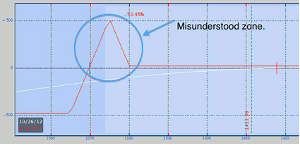A broken-wing butterfly option spread offers the upside of a butterfly, but at a fraction of the cost. Greg Loehr of OptionsBuzz.com and contributor to SMBTraining.com, tracks the hypothetical performance of a broken wing butterfly trade.
After taking a break from blogging, I'm now back to continue contributing to the understanding of what I believe is among the best strategies that a trader can have in his (or her) arsenal: the broken wing butterfly. But just because I've been away from this blog doesn't mean that I haven't been in touch with my students. Quite the opposite in fact.
And after speaking with various SMB followers over the past month or so I've learned that there is one common misperception about the broken wing butterfly strategy. For those who may not be familiar with this type of trade let me quickly describe it for you.
1. Start with a regular butterfly, for instance with strikes
prices $5 apart.
2. The risk is the debit.
3. Turn it into a broken wing
butterfly by moving the furthest OTM option one strike further OTM ($5 in this
example). For a call butterfly, that's the highest strike option. For a put
butterfly, it's the lowest.
4. Voila. You have a broken wing butterfly. The
risk is now $5 plus any debit you pay (or minus any credit you receive).
With a long butterfly, a long broken wing butterfly, or even a credit spread for that matter, the furthest OTM option is an option that you own. But despite owning this option, you do NOT want it to make money. This option is only purchased as insurance against a bigger-than-expected move, and therefore I call it the "insurance" wing.
By moving the insurance wing further OTM, the maximum theoretical risk of the trade is increased, but three major benefits are gained. First, the trade can be entered into for a credit. Therefore it can act very similarly to, and actually be a substitute for, a normal "credit" spread. Second, the trade can potentially produce profits larger than the credit prior to expiration. And third, the trade can potentially produce profits faster than the regular butterfly would.
Take a look at this SPX trade example with options expiring November 2, 2012:
This particular butterfly, priced at a 35-cent credit, has $4.65 of theoretical risk and a potential 7.5% return in one week just from the credit. The maximum theoretical profit is $5.35.
Here's where the misperception comes in. With the insurance wing moved further away, and two short strikes in the middle, it's thought that just about any downward move in the market is going to do serious damage to the trade. Nothing could be further from the truth.
In reality I would consider this trade fairly safe and here's why. If the market drops, the two long options are going to protect the position more than one typically thinks. For instance, at the time I found this trade I calculated that it would take approximately a two standard deviation move before the trade could potentially hit a 20% loss of the maximum risk. A two standard deviation move means that approximately 95% of the moves the market is going to have should exist within that range, which based on the current market volatility is about 34 SPX points.
Of course there are many variable and nuances, but having a trade that can potentially survive a 34-point drop in the SPX before even a 20% loss exit would be a trade that I call "safe". But then again, you have to define for yourself what "safe" means to you.
By Greg Loehr of OptionsBuzz.com is also a contributor to SMBTraining.com























